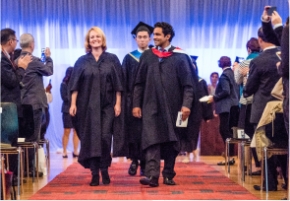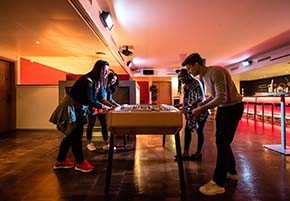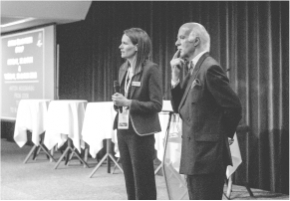- About
- Programs
- Innovation & Research
- Campus Life
- Career Services
- Admissions
- News & Events
- Alumni
Service is a dance
The experience of dining in a Michelin-starred restaurant is more than food; it is an entire experience shaped by the culinary masterpieces presented and the fluid, unobtrusive, and natural flow of service. Staff must learn to provide elegant, gracious, and discrete service and what better way to learn these qualities than through the teachings of a professional dancer?
Have you ever considered the remarkable intersection of fine dining and the art of movement? In the distinguished Fine Dining Leadership and Operation course, César Ritz Colleges students had the opportunity to participate in an innovative, fun, and captivating workshop known as 'Service in Motion.'
The essence of dining in a Michelin-starred restaurant transcends the mere consumption of food; it encompasses an entire experience. This experience is shaped by the culinary masterpieces presented and the fluid, unobtrusive, and natural flow of service. The epitome of luxury dining often involves staff trained to provide elegant, gracious, and discrete service. And what better way to imbue these qualities than through the teachings of a professional dancer?
Dance instruction offers a unique and effective approach to enhancing proprioception, mobility, fluidity, and agility, qualities that are known to be beneficial in sports but are also very valuable in other professions, including the demanding profession of fine dining service. For waitstaff in high-end restaurants, the skills honed through dance can be particularly advantageous, enhancing their ability to provide impeccable service.
Proprioception, the awareness of one's body in space, is a foundational benefit of dance. This heightened body awareness is crucial for waitstaff, who often navigate through tightly packed dining areas with precision and care. Just as a dancer must be acutely aware of their position on stage in relation to other dancers and objects, a waitperson must manoeuvre through a busy dining room, avoiding collisions with patrons, other staff, or obstacles like furniture. This skill reduces the risk of accidents, such as spilling or dropping items, ensuring a smooth dining experience for guests.
Mobility, or the ability to move freely and easily, is significantly enhanced through dance. In the context of fine dining, this translates into the ability to gracefully move around the dining area, reach across tables without strain, and handle tasks like setting tables and serving dishes with ease. This kind of fluid mobility is essential in maintaining the elegance and efficiency expected of high-end dining establishments.
Fluidity and agility, the most direct transfers from dance, are vital for waitstaff. The fluid movement patterns, and quick directional changes practiced in dance prepare waitstaff to move swiftly and efficiently around the dining room, responding promptly to guest requests and easily navigating crowded spaces. For example, a waitperson carrying a tray of delicate glassware or a sommelier presenting a rare bottle of wine can benefit from the smooth, controlled movements learned in dance, minimizing the risk of mishaps, and enhancing the overall dining experience.
Beyond the physical benefits, the mental and emotional aspects of dance, such as focus, memory, and stress management, are also beneficial for waitstaff. The ability to remember complex orders, table numbers, and guest preferences can be likened to a dancer remembering intricate choreography. The stress-relief aspect of dance can help servers maintain a calm, composed demeanor even during peak dining hours, ensuring a pleasant and professional interaction with guests.
Students learning how to dance through the dining room.
This unique 'Service in Motion' workshop begins with students engaging in stretching exercises, setting the stage for physical and mental engagement. They are then presented with various challenges meticulously designed to enhance their control over body movements. A highlight of these challenges includes a teamwork exercise where one student is carefully lifted and carried by their peers, symbolizing their collective ability to 'fly' above conventional service norms. This exercise boosts confidence and fosters communication and trust within the team.
But 'Service in Motion' is more than just physical dexterity. It embodies the ethos of style and grace. As part of their training, students learned the art of navigating around a dining table with poise, ensuring that each movement is purposeful and contributes to a seamless service experience. The students explore the creative parallels between precise choreography and the intricacies of serving at a high level. This process sharpens their proprioception and develops a heightened awareness of space, movement, and timing, enhancing their intuitive intelligence. Ultimately, this workshop equips students with the skills to provide service that anticipates guests' needs and surpasses their expectations, elevating the dining experience to new heights.
For servers and waitstaff, the skills developed in dance - proprioception, mobility, fluidity, and agility - enhance their ability to provide high-quality service. From navigating crowded dining rooms with ease and grace to remembering detailed orders, the parallels between the art of dance and the art of fine dining service are numerous and valuable. This unique training approach contributes to the overall efficiency, elegance, and customer satisfaction that define the high standards of the fine dining experience and the high standards of César Ritz Colleges.
Here's what students said about the workshop:
"The workshop helped us tune in to ourselves internally, raising our awareness of how our external actions impact the workplace and how we can improve and be better perceived by others." Charlotte - from South Korea
"It was such an amazing workshop! We learned about trust and communication with each other". Sean - from Taiwan
"This workshop was a truly unique team-bonding experience." Raid - from Saudi Arabia
"I know how to move more elegantly and quietly after this useful workshop, which is a crucial skill in the industry."
Linh - from Vietnam
About the Guest Lecturer:
Angelo Dello lacono found a passion for ballet as a seven-year-old boy in Italy. Over the next ten years, he devoted himself to rigorous training, which laid the foundation for his future career. After leaving Italy, Angelo embarked on a journey as a professional dancer, taking him across five continents and to more than 30 countries. Throughout his career, he collaborated with respected choreographers, ballet masters, martial arts instructors, and musicians, each contributing to his artistic growth.
He has performed in prestigious theatres and festivals and has shared his expertise at universities and conservatories worldwide. Angelo's experiences and learnings are encapsulated in his book Le Point Zéro where he introduces his unique movement technique.
Currently, Angelo is an artistic director and producer, as well as an ASCA-accredited therapist for ADN Dialect. In this role, he combines dance with body awareness to enhance human potential in various sectors, demonstrating how movement can be a powerful tool for personal and professional development.
For more detailed information about Angelo's work and his approach to integrating dance and body awareness, visit www.adndialect.ch. His career is a blend of artistic expression and a commitment to using dance to enrich and empower individuals in various fields.
Are you interested in moving into your future career with grace and poise? Learn more about César Ritz Colleges.
#Academics
















